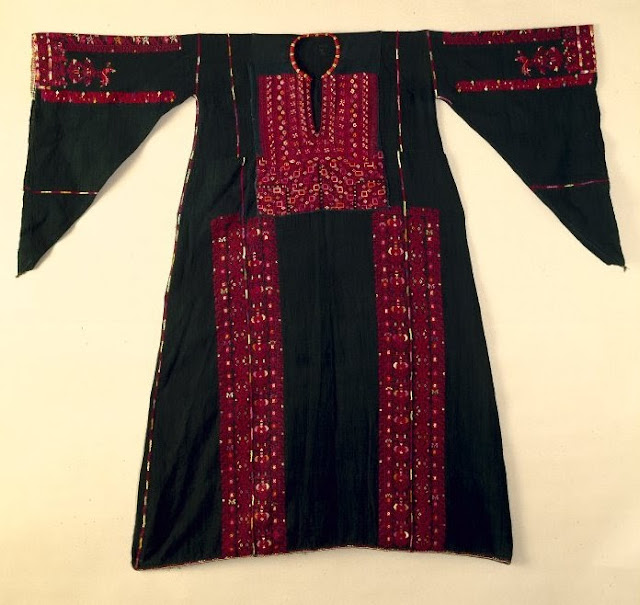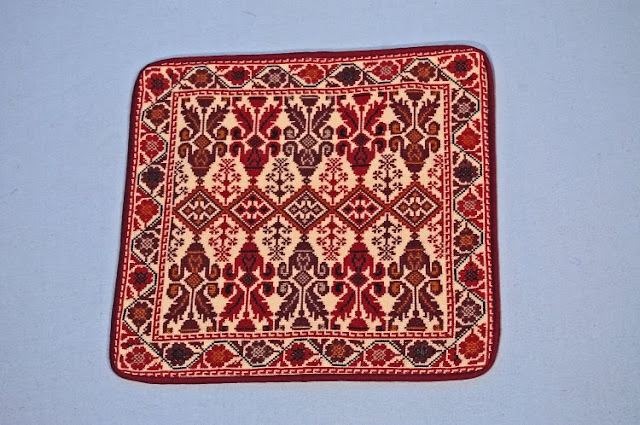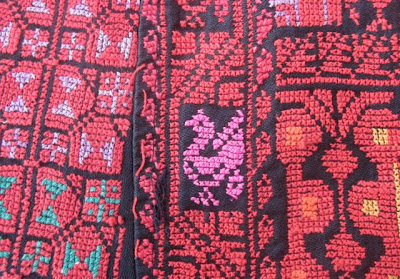Hello all,
This is a photo of my friend Jean modelling a dress which had been given her in 1985. The woman who gave it to her said that she had bought it in Jordan about 15 years previously. It is my belief that it was embroidered and sewn by Palestinian refugees in Jordan, as it is very typical of the embroidered dresses worn by women in the southern half of Israel/Palestine. I wish to state very strongly that I have no political agenda in this article, I am interested in the handiwork and traditional costume of all people. [If anyone has any information on the folk costume of Jordan, I would be very glad to know of good sources.]
I believe this piece to have been made in the 1950's-1960's. The arrangement of the embroidery follows exactly the tradition of the Arabic women who live in this area, the embroidery itself is done in a newer style of Bedouin [Bedu] garments from the Negev. The cross stitch was done on waste-canvas, but the dress itself was sewn by hand. The sleeves are narrow, with a short slit in the cuffs, but there is no slit in the bottom hem. All of these details point to an origin in the mid 20th cent.
There are records of embroidered dresses, called Thobes, being worn by the Arab women in the southern half of Israel/Palestine already in the British Mandate period. There were various local traditions, noteably in the villages around Ramallah, Hebron, Jaffa, Gaza, and Be'ersheba. Bethlehem was and is famous for a different type of embroidery. Some areas did not do embroidery on their dresses. It would seem that originally the cross stitch embroidery was done on white linen garments, as in this example from Ramallah.
Some of the examples from the late 19th cent. were quite simple. You will notice that the arrangement of the embroidery was already the same.
In many villages more elaborate versions were developed, each village having its preferred colors and motifs [although some shade of red was almost always the dominant color], although European copybook motifs were readily adopted and added to the repetoire. Here is one example from the Ramallah region which is in the British Museum.
Here is a closeup of the bib from another piece.
Here is the general cut of the thobe. This basic cut was used by Arabs for both men's and women's robes over quite a large area, including Saudi Arabia and Egypt.
More side panels were added when extra fullness was desired. One word of warning, the bottom edge of the side panels did not end on the same line as shown here, but rather each long side was of the same length, the hem curving up if laid flat. Otherwise the sides would end up being longer and dragging on the ground. Another variant of the cut was used if the cloth was narrow, as would have been the case for home woven materials.
The four most important locations for embroidery are shown above:
1. Qabba - bib or breastpiece,
usually embroidered as a separate piece for convenience.
2. Dhayal - bottom back of the central field.
Note that there is no shoulder seam, as is the case for many traditional garments.
3. Banayiq - side panels.
The embroidery was done vertically, following the seams.
4. Irdan - sleeves.
The sleeves were originally very wide, but became narrow around the mid 20th cent. as this style of embroidery spread from the villages.
Note that these are the exact areas which are embroidered on Jean's thobe, along with the cuffs and hem.
This photo was taken in Ramallah in 1987.
Some more contemporary examples of this costume as worn today.
Closeups of Jean's dress. Front bib, Qabba. As is so often the case in cross stitch, a few motifs are repeated for ornamental effect. This piece is unusual in that the front opening is made quite wide and then backed with an extra piece for modesty's sake. Most commonly the opening is a narrow slit.
The back rear panel, Dhayal. Note a separate ornament worked along the back seam of the side panel. The seam is clearly visible.
The side panels, Banayiq, two on each side, front and back. The ornament embroidered on the side and front seams is different from that embroidered along the back seam. There is also embroidery all along the bottom hem.
The sleeves, Irdan. On this piece, there is also embroidery above the shoulder seam up to the neckline. In older pieces this was often sewn of some different ornamental cloth. The cuffs and neck opening are finished off with a beautiful overcast stitch.
This type of embroidery continues to be made and worn, as well as being transferred to cushions and other decorative items.
Thank you for reading, I hope that you have found this interesting and perhaps inspiring. This type of embroidery is obviously well suited to many types of projects. I will close with a few more random images of this type of embroidery.
The following pieces are all Bedouin. These are the closest in motif and color to Jean's thobe.
Blue embroidery is used by girls and menopausal women. Upon marriage a woman is allowed to embroider her clothes in red. This dress was partly embroidered before marriage.
for the six photos from the blog post "New acquisition - Sinai Desert thob c1960s" 28 Dec 2012:
Bedu thob - Sinai Desert, Egypt
c. late 1960s-1970s
Palestine Costume Archive collectionhttp://palestinecostumearchive.blogspot.com.au/2012/12/new-acquisition-sinai-bedu-thob-c1960s_28.html
Bedu thob - diyal panel, Sinai Desert, Egypt
c.1940s
Palestine Costume Archive collection
http://palestinecostumearchive.com/regional.htm
c.1940s
Palestine Costume Archive collection
http://palestinecostumearchive.com/regional.htm
Full Bedouin Costume
Early 20th century Sinai Desert bedu costumes
in the Palestine Costume Archive's collection
from the Archive's traveling exhibition
"Portraits without names: Palestinian costume"
http://palestinecostumearchive.com/exhibitions.htm
in the Palestine Costume Archive's collection
from the Archive's traveling exhibition
"Portraits without names: Palestinian costume"
http://palestinecostumearchive.com/exhibitions.htm
Feel
free to contact me with requests for research. I hope to eventually
cover all of Europe and the Former Russian Empire/Soviet Union. I also
gratefully accept tips on source materials which i may not have. I also
accept commissions to research/design, sew, and/or embroider costumes
or other items for groups or individuals. I also choreograph and teach
folk dance.
Roman K.
Feel free to contact me at this email address.
Rkozakand@aol.comSource Material:
I would like to sincerely thank the good people at the website and blog 'Palestinian costume archive' for their gracious permission to use their images and material to enrich this article, and, I hope, for more articles on this subject to come. Please visit their website:
http://palestinecostumearchive.com/
Widad Kamel Kawar and Tania Tamari Nasir, 'Stickerei aus Palaestina', Munich, 1989
Shelagh Weir, 'Palestinian Costume', Austin, 1989
Jehan Rajab, 'Palestinian Costume', London, 1989
Abed Al-Samih Abu Omar, 'Traditional Palestinian Embroidery and Jewelry', Jerusalem, 1986












































Thank you Roman, another style of embroidery I had not seen before. The vivid colours on black remind me of stained glass.
ReplyDeleteI am glad that you appreciate it, nays
DeleteWhile we understand your desire not to write a political post, the problem is, you can't write about Palestinian traditional costume in any depth unless you draw a firm line before and after 1948.
DeleteAll of the sources you are quoting discuss Palestinian costume before 1948. The lavishly embroidered and decorated costumes you see in Shelagh, Widad and Jehan's books are long gone. Plus the "bedu" images in Abed Al-Samih Abu Omar's book are completely posed.
Jean's dress is, as you've worked out, c.1960s- 70s. Our museum is one of the very very few that acquires and researches post 1948 Palestinian costume and embroidery. Which is why you've drawn so heavily from our museum's website and blogs in the illustrations you've used to try to work out why her dress doesn't seem to match anything. There's a reason for that which we can share if you're interested. If it's become too political for you, then please pass on to Jean we'd be happy to do a report on her dress if she'd like to drop us a line via Facebook. The only extra info we need is the base fabric of the garment + photos of any fabrics used to line the garment / reinforce cuffs etc - both these things will confirm dating.
We commend you on your Source Material list, that's rare. We may not have made the list but are happy to grant permission to use our images. We hope you won't mind adding the following credit lines to our photos:
1) for the installation photo of three Sinai Desert bedu costumes:
Early 20th century Sinai Desert bedu costumes
in the Palestine Costume Archive's collection
from the Archive's traveling exhibition
"Portraits without names: Palestinian costume"
http://palestinecostumearchive.com/exhibitions.htm
2) Bedu thob - diyal panel, Sinai Desert, Egypt
c.1940s
Palestine Costume Archive collection
http://palestinecostumearchive.com/regional.htm
3) for the six photos from on our staff blog post "New acquisition - Sinai Desert thob c1960s" 28 Dec 2012:
Bedu thob - Sinai Desert, Egypt
c. late 1960s-1970s
Palestine Costume Archive collection
http://palestinecostumearchive.blogspot.com.au/2012/12/new-acquisition-sinai-bedu-thob-c1960s_28.html
Many thanks :)
Thank you very much.
DeleteI will admit that i gather much information online, and as I have been engaging in this research for many years, i sometimes forget where i obtained particular information. [not to mention that images tend to get reposted by sites such as pinterest, often with mistaken attribution.] Now that I am publishing I need to be more careful.
As far as Jean's thob is concerned, It was made for a very tall woman, as it fits her well, and she is over 6 ft. She has passed it on to me since she has recently moved, and needs to downsize her personal collection.
I will dig it out and write you directly with more information about it.
Thank you again
I am very thankful for your kind permission to use your material, as well as to be able to point readers in your direction where you have such valuable and rich information. [please let me know if i have placed the references incorrectly]. Feel free to write me directly at my email: rkozakand@aol.com.
As far as politics, my desire is to avoid being embroiled in some of the vicious conflict which that sometimes engenders. I recognise that Folk Dress is intrinsically tied to self-identity, which inevitably is tied to the political history of any ethnic group. There is a fine line to walk between presenting history accurately without being inflammatory.
I would be interested in information as to how this art has developed since 1948. Unfortunately the 20th cent. has been seen the decline of many of the traditions which I write about.
Why the fu*k would you write "southern israel", delete this post right now and apologise and educate yourself (after editing this), how can you be so ignorant about writing about an indigenous colonised peoples deep and rich culture while mentioning their colonisers aka abusers!!!!!!!!!! f***ing delusional, do not think for a second Palestinians would approve of this nonsense
ReplyDeleteHey, i think this agressive language is completely innapropriate here, this person has such an amazing blog and clearly put a lot of work into this article. Not to belittle the importance of Palestinian autonomy or independence (and i consider myself radically Pro-Palestine as well) but you definetly can encourage or even demand an edit in a much more productive way than cussing out in the comments of this blog post from over ten years ago.
DeleteAgree
DeleteInformative article!
ReplyDeleteImpressive!
ReplyDeleteLook beautiful!
ReplyDeleteDecent work!
ReplyDeleteChiming in to agree that it's critical to understanding these embroidered clothing, to designate and emphasize their identity as Palestinian. They cannot correctly be attributed to Israeli culture- their motifs and dress cuts predate that state. The villages known for particular styles need to be honored with their true Palestinian identity as well, not only since much that is basis for those styles existed for people of Palestine centuries before 1948, but also because Israeli policy has been to absorb, repackage and claim Palestinian culture as if it's Israeli. It is not a matter of politics in this case but instead, a matter of giving respect to the culture of a people whose identity is being suppressed (and terribly, is being as rapidly as possible erased) by a conquering power. With more recently made thobes that history is completely inextricable because the story of occupation and worse is written into the embroidery itself. To engage with Palestinian 'folk costume' without engaging its context is impossible and to say it's better that way is, I hope the author will recognize, disrespectful to the makers and original wearers of these garments.
ReplyDelete